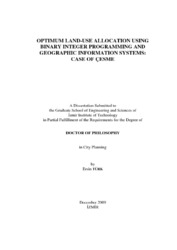Please use this identifier to cite or link to this item:
https://hdl.handle.net/11147/2870Full metadata record
| DC Field | Value | Language |
|---|---|---|
| dc.contributor.advisor | Çelik, Hüseyin Murat | - |
| dc.contributor.author | Türk, Ersin | - |
| dc.date.accessioned | 2014-07-22T13:48:30Z | - |
| dc.date.available | 2014-07-22T13:48:30Z | - |
| dc.date.issued | 2009 | - |
| dc.identifier.uri | http://hdl.handle.net/11147/2870 | - |
| dc.description | Thesis(Doctoral)--Izmir Institute of Technology, City and Regional Planning, Izmir, 2009 | en_US |
| dc.description | Includes bibliographical references (leaves: 98-103) | en_US |
| dc.description | Text in English; Abstract: Turkish and English | en_US |
| dc.description | ix, 103 leaves | en_US |
| dc.description.abstract | Spatial decision making is a very complex process that basic strategy of decision analysis is to divide the decision problem into small, understandable parts; analyze each part; and integrate the parts in a logical manner to produce a rational solution. Recently,Multicriteria Decision Making (MCDM) integrated with geographical information system (GIS) has been promising in producing analytical tools for analyzing many realworld spatial planning and decision making problems.In Turkey, natural, archaeological and cultural assets are conserved according to the decisions of the conservation regional councils. The conservation regional councils decide boundary, type and degree of conservation areas but these areas and their features is changed frequently according to economical, environmental and political atmosphere.The conservation decision is one of the most important input criteria in preparing urban land-use plan since the type and degree of conservation area directly determines which kind of land-uses can and cannot be allocated in a conservation area. The aim of this dissertation is to analyze the effects of changing conservation decisions on optimum land use allocation when all other criteria are constant. This analysis was made with five different perspectives. The thesis uses the land assignment model provided by Hanink and Cromley (1998) that integrates the geographical information systems (GIS) with a generalized assignment model by using MCDM techniques to determine optimum level of conservation scheme. The case study is the master plan area of Çeme in zmir province in Turkey. The results show that the theoretically proposed method is indeed very useful and promising to answer complex issues on a more rational basis. | en_US |
| dc.language.iso | en | en_US |
| dc.publisher | Izmir Institute of Technology | en_US |
| dc.rights | info:eu-repo/semantics/openAccess | en_US |
| dc.subject.lcc | HT169.T9 .T93 2009 | en |
| dc.subject.lcsh | City planning--Turkey--Çeşme | en |
| dc.subject.lcsh | Land use--Planning | en |
| dc.subject.lcsh | Geographic information systems | en |
| dc.subject.lcsh | Integer programming | en |
| dc.title | Optimum Land-Use Allocation Using Binary Integer Programming and Geographic Information Systems: Case of Çeşme | en_US |
| dc.type | Doctoral Thesis | en_US |
| dc.institutionauthor | Türk, Ersin | - |
| dc.department | Thesis (Doctoral)--İzmir Institute of Technology, City and Regional Planning | en_US |
| dc.relation.publicationcategory | Tez | en_US |
| dc.identifier.wosquality | N/A | - |
| dc.identifier.scopusquality | N/A | - |
| item.openairecristype | http://purl.org/coar/resource_type/c_18cf | - |
| item.cerifentitytype | Publications | - |
| item.fulltext | With Fulltext | - |
| item.languageiso639-1 | en | - |
| item.grantfulltext | open | - |
| item.openairetype | Doctoral Thesis | - |
| Appears in Collections: | Phd Degree / Doktora | |
Files in This Item:
| File | Description | Size | Format | |
|---|---|---|---|---|
| T000232.pdf | DoctoralThesis | 11.36 MB | Adobe PDF |  View/Open |
CORE Recommender
Page view(s)
320
checked on Apr 28, 2025
Download(s)
100
checked on Apr 28, 2025
Google ScholarTM
Check
Items in GCRIS Repository are protected by copyright, with all rights reserved, unless otherwise indicated.